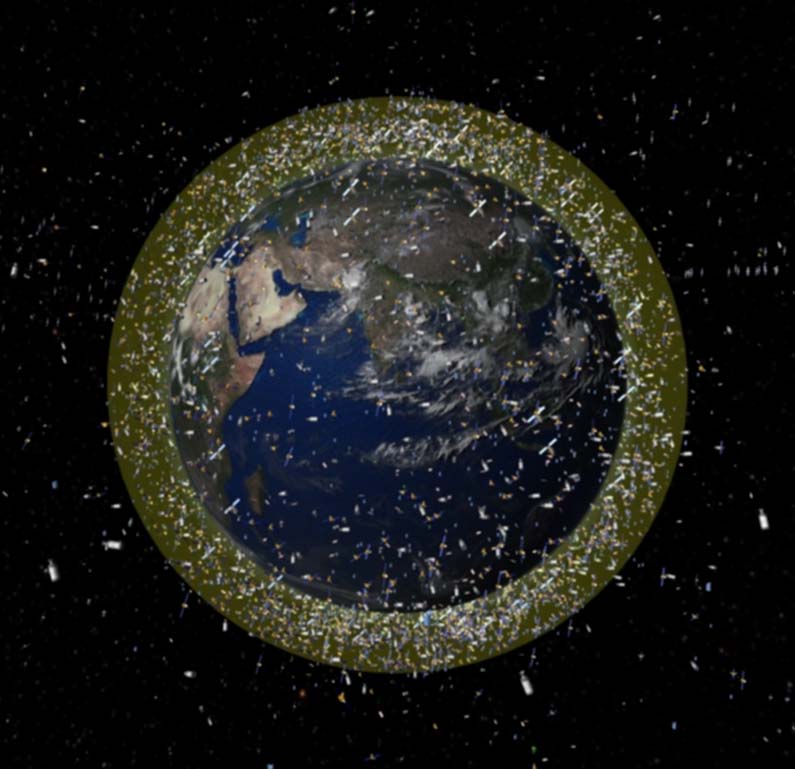Ugly Truth of Space Junk: Orbital Debris Problem to Triple by 2030

COLORADO SPRINGS, Colo. -- Dealing with the decades of detritus from using outer space -- human-made orbital debris -- is a global concern, but some experts are now questioning the feasibility of the wide range of "solutions" sketched out to grapple with high-speed space litter.
What may be shaping up is an "abandon in place" posture for certain orbital altitudes -- an outlook that flags the messy message resulting from countless bits of orbital refuse.
In a recent conference here, Gen. William Shelton, commander of the U.S. Air Force Space Command, relayed his worries about rising amounts of human-made space junk.
"The traffic is increasing. We've now got over 50 nations that are participants in the space environment," Shelton said last month during the Space Foundation’s 27th National Space Symposium. Given existing space situational awareness capabilities, over 20,000 objects are now tracked. [Worst Space Debris Events of All Time]
"We catalog those routinely and keep track of them. That number is projected to triple by 2030, and much of that is improved sensors, but some of that is increased traffic," Shelton said. "Then if you think about it, there are probably 10 times more objects in space than we're able to track with our sensor capability today. Those objects are untrackable … yet they are lethal to our space systems -- to military space systems, civil space systems, commercial -- no one’s immune from the threats that are on orbit today, just due to the traffic in space."
Tough neighborhood
From a probability point of view, General Shelton added, smaller satellites, more debris, more debris is going to run into more debris, creating more debris. [Video: Fragmentation: Growing Threat of Space Junk]
Breaking space news, the latest updates on rocket launches, skywatching events and more!
"It may be a pretty tough neighborhood," Shelton continued, in low-Earth orbit and geosynchronous Earth orbit "in the not too distant future."
When asked if the U.S. Air Force plans on funding space debris mitigation capability, Shelton responded: "We haven’t found a way yet that is affordable and gives us any hope for mitigating space debris. The best we can do, we believe, is to minimize debris as we go forward with our operations. As we think about how we launch things, as we deploy satellites, minimizing debris is absolutely essential and we’re trying to convince other nations of that imperative as well."
Shelton said that, unfortunately, with the duration of most things on orbit, "you get to live with the debris problem for many, many years and in some cases decades. So minimizing debris is important to us and it should be to other nations as well."
Point of no return
The concern over orbital debris has been building for several reasons, said Marshall Kaplan, an orbital debris expert within the Space Department at the Johns Hopkins University Applied Physics Laboratory in Laurel, Md.
In Kaplan's view, spacefaring nations have passed the point of "no return," with the accumulation of debris objects in low-Earth orbits steadily building over the past 50 years.
Add to the clutter, the leftovers of China’s anti-satellite (ASAT) test in 2007.
"The fact that this single event increased the number of debris objects by roughly 25 percent was not as important as the location of the intercept. The event took place at an altitude of 865 kilometers, right in the middle of the most congested region of low-orbiting satellites," Kaplan pointed out.
Toss into the brew the collision of an Iridium satellite with an expired Russian Cosmos spacecraft in February 2009 -- at an altitude similar to that of China’s ASAT test.
As a result of 50 years of launching satellites and these two events, the altitude band from about 435 miles (700 km) to a little over 800 miles (1,300 km) has accumulated possibly millions of debris objects ranging from a few millimeters to a few meters, Kaplan said.
Complex and very expensive
"The buildup of debris is not a naturally reversible process. If we are to clean up space, it will certainly be complex and very expensive. If we continue, as we have, to use these very popular orbits in near-Earth space, the density of debris and collision events will surely increase," Kaplan told SPACE.com.
The good news is that no immediate action is necessary in terms of removing debris objects, Kaplan advised, as experts estimate that the situation will not go unstable anytime soon.
"But, when it does, operational satellites will be destroyed at an alarming rate, and they cannot be replaced. We must prepare for this seemingly inevitable event," Kaplan said. While there are many options for debris removal that have been proposed, he feels that none are sensible.
"Barring the discovery of a disruptive technology within the next decade or so, there will be no practical removal solution," Kaplan added. "We simply lack the technology to economically clean up space." [Lasers Could Zap Space Junk Clear From Satellites]
For Kaplan, the issue of dealing with orbital debris will become dire.
"The proliferation is irreversible. Any cleanup would be too expensive. Given this insight, it is unlikely spacefaring nations are going to do anything significant about cleaning up space," Kaplan said. "The fact is that we really can't do anything. We can't afford it. We don't have the technology. We don't have the cooperation. Nobody wants to pay for it. Space debris cleanup is a 'growth industry,' but there are no customers. In addition, it is politically untenable."
Not a pretty space picture
All that being said, can anything be done? Kaplan says he can imagine the future … and things don't look pretty.
"There is a good chance that we may have to eventually abandon all active satellites in currently used orbits," Kaplan said. "One possible scenario for the future is that we may phase out this generation of spacecraft while replacing them with a brand-new infrastructure of low-orbiting constellations of small satellites, each of which partially contributes to collecting desired data or making communications links."
These constellations could be placed below 370 miles (600 km), thus avoiding the debris issue.
"Such a new infrastructure could be developed over the next 20, 30 or 40 years," Kaplan said. "We should have plenty of time to make the transition, so let's use it wisely. We all caused this problem … there is no doubt about that. And, nobody will claim somebody else did it."
Meanwhile, outer space is still "big" … but it’s getting smaller.
"The question is: when is it going to get too small? That’s the real question, and we don't know," Kaplan said. "Nobody is really going to yell uncle until we have some more serious collisions. That could happen anytime or it could happen in 20 years, we just don't know."
Leonard David has been reporting on the space industry for more than five decades. He is a winner of this year’s National Space Club Press Award and a past editor-in-chief of the National Space Society's Ad Astra and Space World magazines. He has written for SPACE.com since 1999.

Leonard David is an award-winning space journalist who has been reporting on space activities for more than 50 years. Currently writing as Space.com's Space Insider Columnist among his other projects, Leonard has authored numerous books on space exploration, Mars missions and more, with his latest being "Moon Rush: The New Space Race" published in 2019 by National Geographic. He also wrote "Mars: Our Future on the Red Planet" released in 2016 by National Geographic. Leonard has served as a correspondent for SpaceNews, Scientific American and Aerospace America for the AIAA. He has received many awards, including the first Ordway Award for Sustained Excellence in Spaceflight History in 2015 at the AAS Wernher von Braun Memorial Symposium. You can find out Leonard's latest project at his website and on Twitter.



